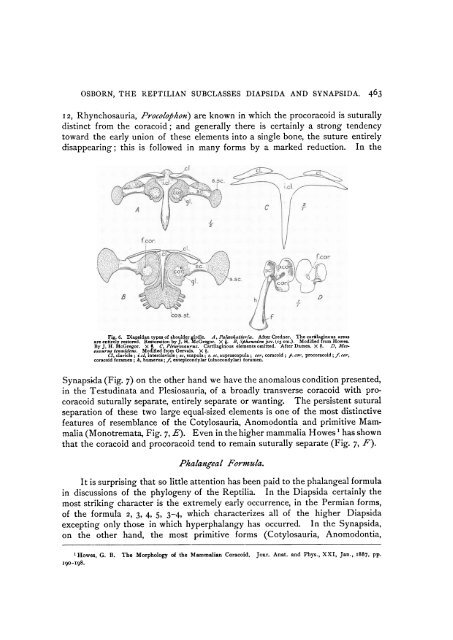American Museum of Natural History
American Museum of Natural History
American Museum of Natural History
Create successful ePaper yourself
Turn your PDF publications into a flip-book with our unique Google optimized e-Paper software.
OSBORN, THE REPTILIAN SUBCLASSES DIAPSIDA AND SYNAPSIDA. 463<br />
1 2, Rhynchosauria, Procolophon) are known in which the procoracoid is suturally<br />
distinct from the coracoid; and generally there is certainly a strong tendency<br />
toward the early union <strong>of</strong> these elements into a single bone, the suture entirely<br />
disappearing; this is followed in many forms by a marked reduction. In the<br />
A<br />
fcor.<br />
(-I~~~~~~~~~~~~~~7<br />
=~~~~~<br />
91 X5<br />
cos.st..<br />
f~~~<br />
~~~~~~~~~~~~~2<br />
Fig. 6. Diapsidan types <strong>of</strong> shoulder girdle. A, Pakeohatteria. After Credner. The cartilaginous areas<br />
are entirely restored. Restorationi by J. H. McGregor. X i. B, Sfihenodon juv. (15 cm.). Modified from Howes.<br />
By J. H. McGregor. X f. C, Pleurosaurus. Cartilaginous elements omitted. After Dames. X Y. D, Mesosaurus<br />
tenuidens. Modified from Gervais. X 4.<br />
CZ, clavicle ; ixc, interclavicle; sc, scapula; s. sc, suprascapula; cor, coracoid; p. cor, procoracoid; f. cor,<br />
coracoid foramen; h, humerus; f, entepicondylar (ulnocondylar) foramen.<br />
Synapsida (Fig. 7) on the other hand we have the anomalous condition presented,<br />
in the Testudinata and Plesiosauria, <strong>of</strong> a broadly transverse coracoid with procoracoid<br />
suturally separate, entirely separate or wanting. The persistent sutural<br />
separation <strong>of</strong> these two large equal-sized elements is one <strong>of</strong> the most distinctive<br />
features <strong>of</strong> resemblance <strong>of</strong> the Cotylosauria, Anomodontia and primitive Mammalia<br />
(Monotremata, Fig. 7, E). Even in the higher mammalia Howes' has shown<br />
that the coracoid and procoracoid tend to remain suturally separate (Fig. 7, F).<br />
Phalangeal Formula.<br />
It is surprising that so little attention has been paid to the phalangeal formula<br />
in discussions <strong>of</strong> the phylogeny <strong>of</strong> the Reptilia. In the Diapsida certainly the<br />
most striking character is the extremely early occurrence, in the Permian forms,<br />
<strong>of</strong> the formula 2, 3, 4, 5, 3-4, which characterizes all <strong>of</strong> the higher Diapsida<br />
excepting only those in which hyperphalangy has occurred. In the Synapsida,<br />
on the other hand, the most primitive forms (Cotylosauria, Anomodontia,<br />
I Howes, G. B. The Morphology <strong>of</strong> the Mammalian Coracoid. Jour. Anat. and Phys., XXI, Jan., 1887, Pp.<br />
190-198.

















